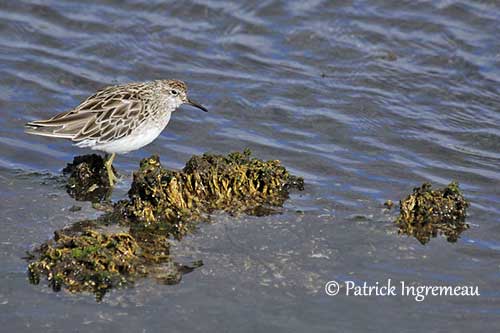
Fr: Bécasseau à queue pointue
Ang: Sharp-tailed Sandpiper
All: Spitzschwanz-Strandläufer
Esp: Correlimos Acuminado
Ita: Piovanello siberiano
Nd: Spisshalesnipe
Sd: spetsstjärtad snäppa
Photographers:
Aurélien Audevard
OUESSANT DIGISCOPING
Ken Havard
My Bird Gallery & Flickr gallery 1 & Flickr gallery 2
Patrick Ingremeau
TAMANDUA
Text by Nicole Bouglouan
Sources:
HANDBOOK OF THE BIRDS OF THE WORLD Vol 3 by Josep del Hoyo-Andrew Elliott-Jordi Sargatal - Lynx Edicions - ISBN: 8487334202
SHOREBIRDS by Peter Hayman, John Marchant and Tony Prater – Christopher Helm – 1986 – ISBN: 0747014035
GUIDE DES LIMICOLES de D. Taylor - Delachaux et Niestlé - ISBN : 2603014080
Bird Web (Seattle Audubon Society)
Department of Sustainability, Environment, Water, Population and Communities
What Bird-The ultimate Bird Guide (Mitchell Waite)
Wikipedia, the free encyclopaedia
Sharp-tailed Sandpiper
Calidris acuminata
Charadriiformes Order – Scolopacidae Family
INTRODUCTION:
The Sharp-tailed Sandpiper is closely related to the Pectoral Sandpiper, and both species are long-distance migrants, with overlapping breeding range in Siberia.
The sharp-tailed Sandpiper breeds in the northernmost regions of Siberia, on Arctic and sub-Arctic tundra. It is strongly migratory and travels long distances to its wintering areas in New Guinea, Australia, New Zealand and adjacent areas.
The male performs spectacular aerial displays accompanied by distinctive sounds.
The population appears currently stable and the species is not globally threatened.

DESCRIPTION OF THE BIRD:
Biometrics:
Length: 17-22 cm
Wingspan: 36-43 cm
Weight: M: 53-114 g – F: 39-105 g
The sharp-tailed Sandpiper in breeding plumage has dark brown upperparts with chestnut and whitish-buff fringes. On the upperwing, the wing-coverts are grey-brown with paler fringes. The dark brown flight-feathers are crossed by a narrow, white wingbar, formed by the white tips of greater and primary coverts. Mantle, scapulars and tertials are mostly blackish-brown with paler fringes. Rump and uppertail-coverts are blackish, but the rump sides are white. The tail is brownish with darker central rectrices. It is wedge-shaped with rather pointed rectrices.
On the underparts, chin, throat, face, neck and upper breast are tinged buffish and heavily streaked brown. On the white lower breast and flanks, the streaks become conspicuous chevrons. The undertail-coverts are white and streaked brown. On the underwing, coverts and axillaries are white and slightly washed grey.
On the head, the crown is streaked dark brown and chestnut. The paler supercilium is faintly marked with some dark streaks in front of the eye, whereas it becomes whitish and clearer behind eye. Lores and ear-coverts are brownish and slightly streaked darker. The hindneck is streaked brown and whitish.
The bill is blackish with paler tinge at base, especially on lower mandible. The eyes are dark brown. Legs and feet are yellowish or greenish or brownish.
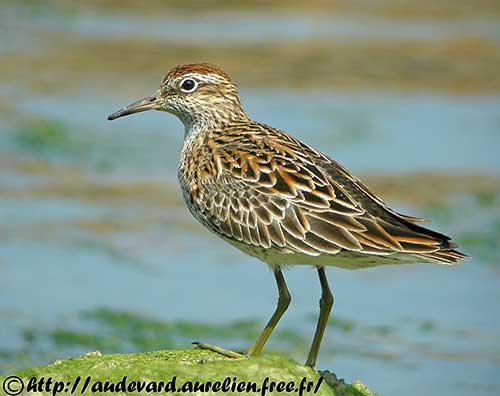
The sharp-tailed Sandpiper in non-breeding plumage is fairly similar but duller on crown, whereas the supercilium is more conspicuous and the ear-coverts appear darker. On mantle and scapulars, the feathers have large brown centres and paler fringes.
The underparts are whitish with greyish wash and narrow brown streaks on neck and breast. A dark breast band may appear during the moult.
Male and female are similar but the female is 5/10% smaller, with shorter wings.
The juvenile has bright rufous crown and long, white supercilium, whereas lores and ear-coverts are dark reddish. The upperparts show buff, chestnut and whitish fringes.
On the underpart, the breast is orange-buff with indistinct dark streaks forming a narrow gorget, sometimes broken in centre. Flanks are tinged buff, becoming duller progressively as the bird is growing.

RANGE:
The sharp-tailed Sandpiper breeds in NC and NE Siberia, from Lena Delta to R Kolyma. It winters from New Guinea through Melanesia to New Caledonia and Fiji, and S to Australia and New Zealand.
HABITAT:
The sharp-tailed Sandpiper breeds on Siberian tundra with wet peaty hollows and drier hummocks covered with shrubs, but also in marshes, swamps and mudflats.
On the wintering grounds, it frequents a variety of coastal and inland wetlands such as flooded grassland, intertidal mudflats, brackish lagoons, river mouths, rice fields, flooded fields, mangroves, rocky shores and beaches.
CALLS AND SONGS: SOUNDS BY XENO-CANTO
The sharp-tailed Sandpiper gives typical calls, often uttered in short-twittering sequence “teet-teet-trrt-trrt” or “prtt-wheet-wheet” fairly similar to Barn Swallow’s calls.
The song is given on the breeding grounds. It includes a long, muffled trill and a low-pitched, aspirated “hoop”.
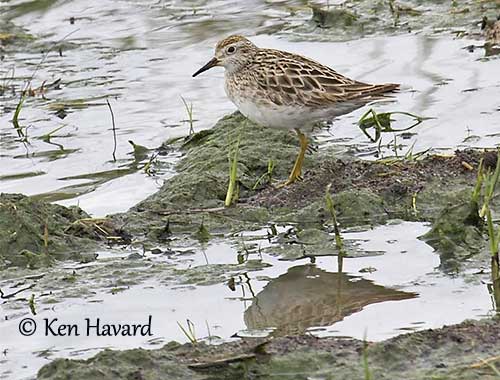
BEHAVIOUR IN THE WILD:
The sharp-tailed Sandpiper feeds on aquatic insects and their larvae and other invertebrates such as bivalves, snails, worms and crustaceans. It also consumes some seeds.
It forages among the vegetation and often at water edge, and on grassland. It probes into the soil with the bill with rapid movements, but it also forages by sight, pecking and jabbing with rapid shallow probing.
The sharp-tailed Sandpiper is gregarious and frequently feeds in large flocks that often fragment into scattered groups. In order to avoid detection, it often crouches while feeding.
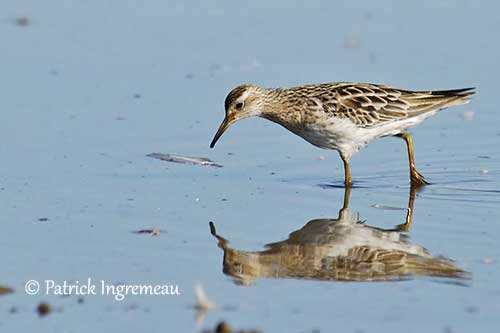
The breeding habits of this species are poorly known. However, the male performs a song flight with short ascents followed by descending glides on upraised wings. During the flight, the large breast sac produces a dry, crackling warbler, different from other Calidris vocalizations.
The male is polygynous and mates with several females, but it usually leaves the area after the egg-laying. It does not take part in chick rearing.
The sharp-tailed Sandpiper is migratory. It leaves the breeding grounds in July/September, and arrives in Australia between August and November. The return migration to N occurs between early February and early March. It is vagrant in several regions/countries, with fall migrants in Alaska and NW Pacific. It is a rare vagrant in Europe, but it occurs in several countries in S and SE Asia.
It has swift flight with rapid wingbeats and migrates in series of short flights.
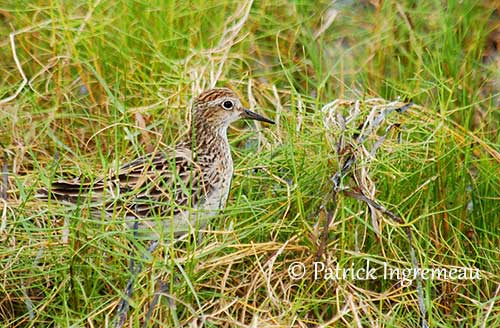
REPRODUCTION OF THIS SPECIES:
The egg-laying occurs in June. The sharp-tailed Sandpiper breeds with a density of up to 20 birds/km² and they nest on the ground. The nest is a shallow depression lined with leaves and grasses, well-hidden among vegetation. This species produces a single brood per season.
The female lays 3-4 olive-grey/olive-brown eggs with dark spotting, making them very cryptic on the ground. The male leaves after the laying. She incubates alone during 19-23 days. The chicks leave the nest soon after hatching, tended by the female. They are able to fly at 18-21 days old. The female may perform some distraction displays if a predator approaches the nest-site or the chicks.
PROTECTION / THREATS / STATUS:
The sharp-tailed Sandpiper is not globally threatened, and the population is currently stable. It is estimated to number more than 160,000 individuals (2006).
The sharp-tailed Sandpiper is evaluated as Least Concern.
